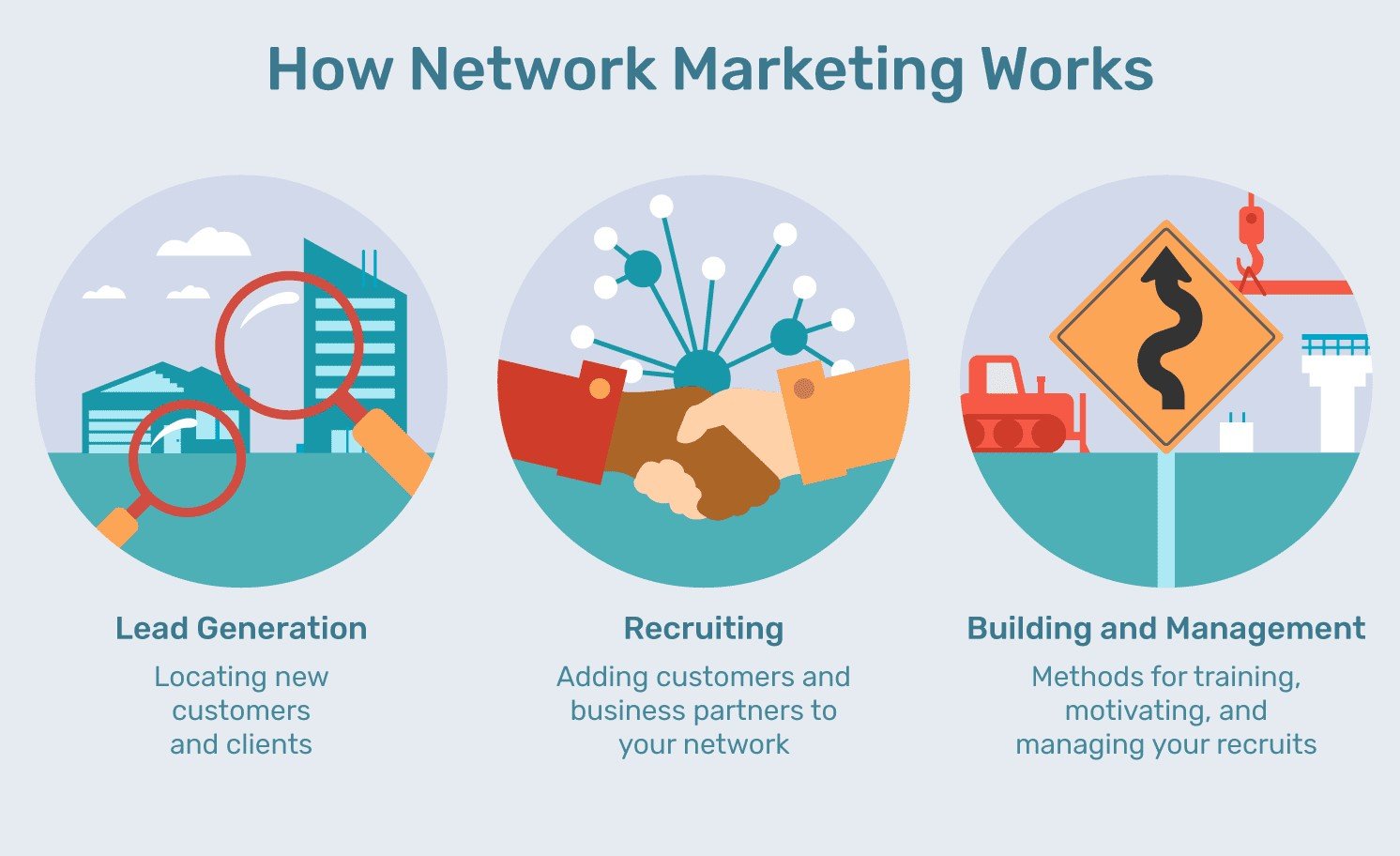Multi-Level Marketing explained has become a prominent business model, captivating entrepreneurs and consumers alike with its unique approach to sales and distribution. In this comprehensive guide, we will delve into the intricacies of MLM, providing a detailed exploration of its structure, operations, advantages, and challenges.
By the end of this guide, you’ll gain a nuanced understanding of MLM, enabling you to navigate its opportunities and pitfalls with informed decision-making. Let’s embark on a journey to unravel the layers of Multi-Level Marketing explained and unlock the key insights that define this dynamic industry.
Multi-Level Marketing explained Structure

Multi-Level Marketing (MLM) is characterized by a distinctive organizational framework that sets it apart from traditional business models. At its core, the MLM structure resembles a pyramid, with multiple levels of distributors interconnected through a network. Understanding the key components of this structure is essential for grasping how MLM operates. Let’s explore the fundamental elements that define the Multi-Level Marketing explained:
Pyramid Structure:
- MLM organizations adopt a pyramid-like shape, emphasizing the hierarchical arrangement of participants.
- Distributors are organized into levels, forming a pyramid where each level represents a tier of the network.
Distributor Hierarchy:
- Participants in an MLM system are categorized into different levels or tiers based on their recruitment and sales achievements.
- Each distributor has a sponsor, the individual who recruited them, and can sponsor others to build their own downline.
Compensation Plans:
- MLM companies implement various compensation plans to reward distributors for their sales and recruitment efforts.
- Common compensation structures include binary, matrix, unilevel, and stair-step breakaway plans, each influencing how commissions are earned and distributed.
Understanding the intricacies of the MLM structure is crucial for individuals looking to engage in Multi-Level Marketing explained ventures, as it directly influences the dynamics of recruitment, sales, and overall success within the network. In the subsequent sections of this guide, we will explore these aspects in greater detail, shedding light on the mechanics that drive the MLM engine.
Strategic Multi-Level Marketing Techniques for Unparalleled Growth
How MLM Works

Multi-Level Marketing (MLM) operates on a unique business model that emphasizes both product or service sales and the recruitment of new participants. At its core, individuals, known as distributors, enter the Multi-Level Marketing explained system by joining a company as independent contractors.
These distributors earn commissions through the sale of the company’s products or services and, crucially, by building a network of recruits, forming what is commonly referred to as a “downline.” As distributors recruit others into the MLM structure, they become sponsors and earn bonuses or commissions based on the sales and recruitment activities of their downline.
The network continues to expand as new participants join, creating multiple levels of hierarchy within the organization. This interconnected structure is designed to incentivize both individual sales success and team building, with the promise of potentially lucrative returns for those who can effectively balance product promotion and recruitment efforts. In the subsequent sections, we will delve deeper into the mechanics of recruiting, product promotion, and the overall dynamics that drive success in the MLM industry.
Pros and Cons of MLM
Pros
Flexibility and Autonomy:
- MLM offers participants the flexibility to set their own schedules and work at their preferred pace.
- Distributors have the autonomy to choose their marketing strategies and methods.
Income Potential:
- Successful MLM participants can achieve significant income through both direct sales and commissions from their downline.
- The opportunity for unlimited earnings exists, especially for those with a robust network and effective sales skills.
Entrepreneurial Opportunities:
- MLM allows individuals to start their own business with relatively low initial costs compared to traditional entrepreneurship.
- Participants can experience entrepreneurship without the need for creating products or handling inventory.
Training and Support:
- Many MLM companies provide training, support, and marketing materials to help distributors succeed.
- Participants can benefit from the experience and guidance of their upline sponsors.
Cons
Pyramid Scheme Concerns:
- MLM structures can be mistaken for pyramid schemes, raising ethical concerns.
- Pyramid schemes are illegal and focus on recruitment rather than legitimate product or service sales.
High Turnover Rates:
- Many individuals who join MLMs may experience challenges in building a sustainable business, leading to high turnover rates.
- The competitive nature of recruiting and sales can result in a lack of long-term commitment from participants.
Emphasis on Recruitment:
- Some MLMs place excessive emphasis on recruitment, potentially overshadowing the focus on product or service quality.
- This emphasis can contribute to a perception that MLMs prioritize recruitment over genuine product value.
Market Saturation:
- In certain MLM sectors, market saturation can be a challenge as more distributors enter the market, making it harder for new participants to establish themselves.
- Saturated markets may limit growth opportunities and lead to increased competition.
Understanding the pros and cons of Multi-Level Marketing explained is crucial for individuals considering involvement in this business model. While some find success and fulfillment in MLM, others may encounter challenges that require careful consideration and evaluation before making a commitment.
Common Misconceptions

Despite the widespread presence of Multi-Level Marketing explained in the business landscape, several misconceptions persist that contribute to both skepticism and confusion. One prevalent misunderstanding is the conflation of MLMs with illegal pyramid schemes.
While pyramid schemes focus solely on recruitment, MLMs operate within legal bounds by incorporating legitimate product or service sales into their business models. Distinguishing between the two is crucial for accurately assessing the ethical standing of an MLM opportunity.
Another misconception revolves around the assumption that all MLMs are inherently exploitative or unsustainable. While certain MLM companies may engage in unethical practices, it is essential to recognize that not all MLMs follow the same path. Legitimate Multi-Level Marketing explained prioritize product quality and adhere to ethical business practices, providing genuine opportunities for individuals to build successful businesses.
Additionally, there is often a misunderstanding regarding the nature of Multi-Level Marketing explained relationships, with critics sometimes characterizing them as solely focused on recruitment rather than fostering genuine product advocacy. In reality, many MLM companies encourage distributors to become product enthusiasts and knowledgeable advocates, emphasizing the value of authentic engagement with the offerings.
Addressing these misconceptions is pivotal for fostering a nuanced understanding of MLM, enabling individuals to make informed decisions about participating in this business model. In the subsequent sections, we will delve deeper into differentiating between legal MLM structures and illegal pyramid schemes, shedding light on the diverse landscape within the MLM industry.
Success Strategies in MLM
Success in Multi-Level Marketing explained hinges on a combination of strategic approaches and interpersonal skills. Building and nurturing relationships with both customers and downline members is paramount, emphasizing the importance of genuine connections over mere transactions. Effective marketing techniques, such as leveraging social media platforms and employing persuasive communication, play a pivotal role in expanding one’s network.
Continuous learning and adaptation to industry trends are equally critical, ensuring that Multi-Level Marketing explained participants remain agile and well-informed in an ever-evolving business landscape. Success in MLM is not solely reliant on recruitment but encompasses a holistic approach that integrates product knowledge, relationship-building, and adaptability.
Legal and Ethical Considerations

Navigating the realm of Multi-Level Marketing explained requires a keen awareness of legal and ethical considerations. MLM companies operate within a framework of regulations that vary by jurisdiction, and participants must ensure compliance with these laws to avoid legal complications. Ethical practices, such as transparent communication about potential earnings and realistic expectations, are vital for maintaining trust among distributors and consumers.
Additionally, a commitment to consumer protections ensures that products or services promoted within the MLM structure meet quality standards. Understanding and adhering to both legal requirements and ethical principles are fundamental aspects of sustaining a reputable and compliant Multi-Level Marketing explained business.
Related Topics
The Power of Multi-Level Marketing Software Solutions
Multi-Level Marketing Services Unveiled
Multi-Level Marketing Tax Tips
Conclusion
In this comprehensive guide, we’ve unraveled the layers of Multi-Level Marketing explained, shedding light on its structure, operations, advantages, and challenges. From the pyramid-like hierarchy to the intricacies of compensation plans, we explored the dynamics that define MLM. Recognizing the potential for flexibility, autonomy, and entrepreneurial opportunities, we also delved into the pitfalls, including concerns about pyramid schemes and high turnover rates.
Clarifying common misconceptions and emphasizing success strategies, we provided insights for individuals navigating the Multi-Level Marketing explained landscape. Finally, we highlighted the significance of legal compliance, ethical considerations, and consumer protections in ensuring the sustainability and reputation of an MLM venture. Armed with this knowledge, readers can approach MLM opportunities with a nuanced understanding, enabling informed decision-making in this dynamic business model.
Other Questions
What is Multi-Level Marketing (MLM)?
MLM is a business model that involves a hierarchical network of distributors who earn commissions from both product sales and the recruitment of new participants.
How does the Multi-Level Marketing explained work?
The MLM structure is pyramid-shaped, with distributors organized into levels. Participants earn commissions not only from their sales but also from the sales and recruitment activities of their downline.
What are the advantages of participating in MLM?
Advantages include flexibility, entrepreneurial opportunities, the potential for significant income, and access to training and support from the MLM company.
What are the common misconceptions about MLM?
One misconception is the confusion between Multi-Level Marketing explained and illegal pyramid schemes. It’s essential to differentiate between the two. Additionally, there’s a misconception that all MLMs are exploitative, whereas legitimate ones prioritize product quality and ethical practices.




